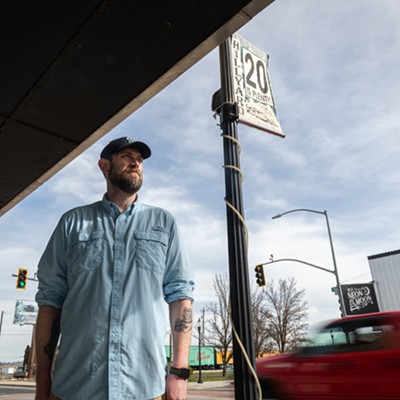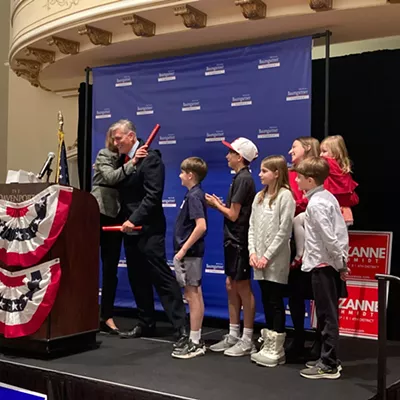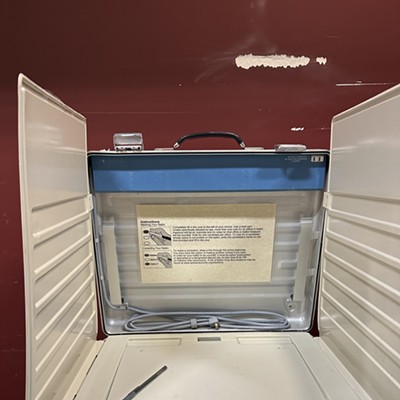If the gods were smiling on Hillyard, they would look down at its manifold problems -- poverty, crime, unemployment and pollution -- and, like the playwrights of classical Greece, lower from the sky a deus ex machina to provide neat solutions to its problems and secure a happy and prosperous future. Someone of the Olympian stature and vaulting ambition of Hillyard's founder, James J. Hill, the Empire Builder, might be up to the task.
Shrewd and ruthless, Jim Hill had no more fear of the Herculean task of building a transcontinental rail line than a farmer might have of cutting his hay. Though transcontinental rail lines already existed to the north and south, the railroad titan built the Great Northern "without the gift of a dollar or an acre of land," according to his 1916 obituary in the Spokesman-Review. In the space of seven and a half months, 8,000 men laid down 643 miles of track. People said it would never pay, ridiculing it as Hill's Folly. Hill proved them all wrong, of course, bringing the Great Northern Railway to Puget Sound in 1893. Of all the lines that reached the West Coast, Hill's was the only one to survive intact. James J. Hill made millions and died a very wealthy man.
Problems Aplenty
Unfortunately, there is no latter-day Jim Hill, and the gods have not smiled on the people of Hillyard, not for decades. They lost the railroad in the early 1980s, and then Kaiser in the late '90s, and the community has simply never recovered. As one of Northeast Spokane's representatives on the City Council, Bob Apple says, Hillyard has had "lots of kicks in the gut," but the departure of the two major employers accounted for "monumental losses of jobs and income."
Marj Brewer has lived in Hillyard for 51 years and can remember a time when it seemed like "half the people worked for the railroad and the other half for Kaiser." Those weren't just jobs, but well-paid blue-collar jobs.
As a result, Hillyard has one of the lowest income levels of any neighborhood in Spokane. According to figures from the 2000 census, the average per capita annual income is $13,580, and nearly 35 percent of families live on less than $25,000 per year.
Apple says that Hillyard has the "the highest percentage of single-parent families" in the city. Not so coincidentally, education levels are also low. Apple says one of every four students who starts at Rogers High School never graduates -- a startling statistic in itself. Levels of higher education are low too; only 8.2 percent of Hillyard residents have college degrees.
With the good jobs gone and the tax base eroded, Hillyard fell on hard times. To add insult to injury, Dave Griswold, owner of Guardian Self Storage in the East Hillyard industrial area, says "people see Hillyard as a dumping ground" for debris from outside the area as well as a magnet for criminal activity, such as meth labs and chop shops. He is quick to add that police response has improved as citizens have worked more closely with COPS Northeast and made their complaints heard. "If we yell at the police, they start coming," Griswold says.
Apple, who owns Comet Tavern and Comet Roofing, both in Hillyard, says meth, especially, dogs Hillyard. He claims that any employer in the neighborhood has had to deal with employees who may fall prey to the drug. But Apple isn't so sure his neighbors are willing to work with the police, saying neighbors and relatives are unwilling to turn in their own. "That's just Hillyard," he says.
Pollution is another facet of Hillyard's industrial legacy, and one about which residents seem to have a curious disconnect. The Environmental Protection Agency has granted $1 million to Spokane to clean up the light to moderately contaminated areas, called brownfields, specifically because they inhibit expansion and redevelopment. Apple, for one, thinks the cheaper land compensates for the uncertainty and potential expense that brownfields pose for prospective businesses. Besides, he asks, "What else are you going to do with it?"
While Griswold admits that "it is a headache" for businesses who have to deal with brownfields, he points to Talisman Construction as an example of a company that came in, cleaned up a brownfield and is now flourishing. He insists that the brownfields are only in about six or seven places in East Hillyard. Besides, he says, because the community is "being proactive and looking at solutions," the presence of the brownfields will not work "to reduce the progress of Hillyard."
Still Chugging Along
In the face of their problems, Hillyardites are determined to show progress. They are organized, allied, committeed, partnered and associated to a fare-thee-well. There is the Greater Hillyard Business Alliance, the Historic Hillyard Partnership, the Hillyard Steering Committee, the Hillyard Neighborhood Council and the Hillyard Festival Association. At a recent neighborhood meeting, one resident joked about the confusion among city officials and supporters as to who is doing what in the various groups. At the most basic level, what they are all doing is building a community identity, with the pride and cohesion that flow from that.
The community that arose out of Jim Hill's rail yard -- Hill's Yard -- has tied its identity to its rich railroad past. It has been designated a local historic district, and property owners have agreed to maintain the historic character of their buildings. The Hillyard Heritage Museum is the project that most directly builds on that past. In development since 1990, and propelled largely by the efforts of Marj and Mike Brewer and Tom Heckler, what it has to show now are four rail cars, open during the three days of the Hillyard Festival and by appointment. The Brewers own the property at Market and Queen, next to the Alaskan Tavern, on which they hope the museum visitor center will eventually be built. They have several designs done by WSU architecture students, but they have not settled on a final design or a proposed budget.
Where will the funding come from? This is where Hillyard's "communication problem," as Dave Griswold calls it, reveals itself. Marj and Mike Brewer would like the community to buy the property, though they realize that is not likely to happen anytime soon. Tom Heckler, for his part, believes the Brewers will eventually donate the property to Hillyard. Heckler spends his Saturdays at the Market Street Market collecting a few dollars for old record albums and the like. His proceeds go to the museum and offset the lease of the railroad land on which the boxcars currently rest. (Heckler has been paying expenses out of his own pocket.) Major events like the Hillyard Festival in August contribute no funds to the project because they only take in enough to pay their own costs. The result is that a project that embodies Hillyard's history has staggered on for 15 years -- kept alive by a dedicated few rather than being the focus of a coordinated effort by the neighborhood's civic groups.
For a community that is trying recast itself as a place that is clean, safe and attractive, streetscape improvements to the historic business core are essential, says Sandy Martin of the Historic Hillyard Partnership. Without repaved streets, improved parking, new sidewalks, street trees, lighting, benches and even garbage cans, the six blocks of the historic core -- bordered by Haven, Diamond, Green and Wabash -- cannot become a pedestrian-friendly destination, like the Perry and Garland neighborhoods that visitors will want to "saunter through rather than just in-and-out," she says.
Martin acknowledges that many of her neighbors nurse a sense of injury and resentment toward the city, believing it has ignored Hillyard, but she disagrees with "the ones who want grant monies to do what they as business owners should be doing. The city should work with Hillyard," Martin says, not bail it out. She also points out the upside of being ignored by the city for so long is that it left the historical buildings intact. "Now when we look back, we're glad they did," she says.
Another project that will alter Hillyard forever is the North-South Freeway Corridor, though opinion is divided as to its effect. Apple thinks it is essential: "The freeway is primary to encouraging business that will give living-wage jobs to our people," he says. He's referring to the larger companies in the industrial park, like grocery distributor URM, which needs to be able to move goods efficiently. Griswold, however, believes "Hillyard is being split right down the middle" by the freeway, which, even with the on- and off-ramps at Wellesley and Francis, could leave it "a ghost town."
Ann-Marie Hamilton of the Greater Hillyard Business Alliance doesn't think Hillyard is going to become a ghost town, but she does think it needs to "get up to speed." She and her husband Dwight own TurboBurn, which produces custom heating systems. Though she grew up in Hillyard, Ann-Marie has only lived there for the last five years. On the plus side, she says, "Hillyard has so many jewels" -- a genuine history and intact historic buildings -- that all it needs is some polishing. She agrees, however, with Griswold about Hillyard's communication problems, citing frequent animosity among business owners as an example. And she says there is a kind of "poverty-level mentality" that makes people suspicious of change -- an attitude that "we don't do things like that here" -- that is tough to overcome.
When she broached consulting with EWU business faculty, people didn't see how that might help the business district. To help get the business district up to speed, Hamilton would like to see more diverse businesses to attract more locals and bring Hillyard into the world of e-commerce. Antique stores could form a virtual antique mall, she says, and the entire business district could develop an online presence as well. There are lots of ideas out there.
Pride Persists
To the casual observer, Hillyard, with its myriad problems, may look like a hopeless case, but Neighborhood Council Chair Dave Griswold rejects that notion. Though the community "has been downtrodden and beaten so far down into the asphalt," says Griswold, it retains "a deep sense of pride." In the coming years, he would like to see Hillyard residents "move away from grants and doles and look at ways to improve their own destiny."
In this old, bedraggled neighborhood, whose history is so bound up with its railroad beginnings, you can almost hear the Little Engine That Could chugging along patiently, sustained only by its belief in itself: "I think I can, I think I can, I think I can."





















